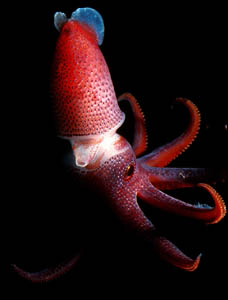![[Metroactive Features]](/features/gifs/feat468.gif)
[ Features Index | Silicon Valley | Metroactive Home | Archives ]
Photograph by Steven Haddock
Five Quick Facts About Glowing Sea Life
* In the case of some jellies, the spark of blue bioluminescence can also activate the fluorescent proteins in their transparent bodies, meaning they can get double the glow with little extra energy output.
* Both luminescent processes create so-called "cold light," because no heat is emitted.
* There are several reasons for creatures to bioluminesce. They can use it for camouflage, as a lure for prey, for distracting predators, and possibly even for mating.
* Another way that marine animals can appear to glow is by the diffraction of light on moving parts such as cilia. This rainbow effect is often mistaken for bioluminescence.
[ Silicon Valley | Metroactive Home | Archives ]
Copyright © Metro Publishing Inc. Metroactive is affiliated with the Boulevards Network.
For more information about the San Jose/Silicon Valley area, visit sanjose.com.
![]()
 Hey Baby, Got A Light?: Communing in the deep sea requires real chemical reactions ... which can now be lifted for scientifical purposes.
Hey Baby, Got A Light?: Communing in the deep sea requires real chemical reactions ... which can now be lifted for scientifical purposes.
* There are two ways that sea creatures like jellyfish luminesce: bioluminescence and fluorescence. Bioluminescence is a chemical reaction between luciferin, which is an energy-intense molecule, and luciferase, an enzyme. When these two interact with calcium or oxygen, which are present in many interactions in the human body, a short burst of light is emitted. Fluorescence is the absorption of light at one wavelength, say blue, and then the re-emission of that light at a different wavelength, like green.
Send a letter to the editor about this story
.
From the June 6-12, 2002 issue of Metro, Silicon Valley's Weekly Newspaper.